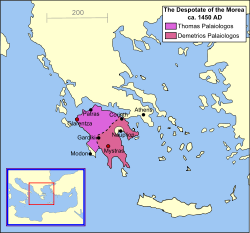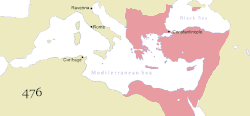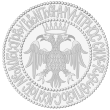Despotate of the Morea
This article needs additional citations for verification. (March 2009) |
Despotate of the Morea Δεσποτᾶτον τοῦ Μορέως | |||||||||
|---|---|---|---|---|---|---|---|---|---|
| 1349–1460 | |||||||||
Seal of Demetrios Palaiologos as Despot of the Morea
| |||||||||
 The Despotate of the Morea in 1450, divided between the two brothers, Thomas and Demetrios Palaiologos | |||||||||
| Status | Semi-autonomous appanage of the Byzantine Empire | ||||||||
| Capital | Mystras (main capital, 1349–1460) | ||||||||
| Common languages | Despot of Morea | | |||||||
• 1349–1380 | Manuel Kantakouzenos | ||||||||
• 1449–1460 | Thomas Palaiologos and Demetrios Palaiologos | ||||||||
| Historical era | Late Medieval | ||||||||
• Established | 1349 | ||||||||
| 1453–1454 | |||||||||
| 29 May 1460 | |||||||||
| |||||||||
| Today part of | Greece | ||||||||
| History of the Byzantine Empire |
|---|
 |
| Preceding |
|
| Early period (330–717) |
|
| Middle period (717–1204) |
| Late period (1204–1453) |
| Timeline |
| By topic |
|
|
The Despotate of the Morea (
History
The Despotate of the Morea was created out of territory seized from the
A later Byzantine emperor,
Subsequent despots were the sons of the Emperor Manuel II Palaiologos, brother of the despot Theodore: Theodore II, Constantine, Demetrios, and Thomas. As Latin power in the Peloponnese waned during the 15th century, the Despotate of the Morea expanded to incorporate the entire peninsula in 1430 with territory being acquired by dowry settlements, and the conquest of Patras by Constantine. However, in 1446 the Ottoman Sultan Murad II destroyed the Byzantine defences—the Hexamilion wall at the Isthmus of Corinth.[2] His attack opened the peninsula to invasion, though Murad died before he could exploit this. His successor Mehmed II "the Conqueror" captured the Byzantine capital Constantinople in 1453. The despots Demetrios and Thomas Palaiologos, brothers of the last emperor, failed to send him any aid, as Morea was recovering from a recent Ottoman attack. Their rule was unpopular, however, resulting in an Albanian–Greek revolt against them, during which they invited Ottoman troops to help them put down the revolt. At this time, a number of influential Greek archons made peace with Mehmed.[3] After more years of incompetent rule by the despots, their failure to pay their annual tribute to the Sultan, and finally their own revolt against Ottoman rule, Mehmed came into the Morea in May 1460. Demetrios ended up a prisoner of the Ottomans and his younger brother Thomas fled. By the end of the summer, the Ottomans had achieved the submission of virtually all cities possessed by the Greeks.
A few holdouts remained for a time. The rocky peninsula of
After 1461, the only non-Ottoman territories were possessed by Venice: the port cities of
Byzantine despots of the Morea
House of Kantakouzenos (1349–1383)
| Name | Reign | Relation |
|---|---|---|
| Manuel Kantakouzenos | 1349–1380 | Son of Emperor John VI Kantakouzenos |
| Matthew Kantakouzenos | 1380–1383 | Son of Emperor John VI Kantakouzenos |
| Demetrios I Kantakouzenos | 1383 | Son of Matthew |
House of Palaiologos (1383–1460)
| Name | Reign | Relation |
|---|---|---|
| Theodore I Palaiologos | 1383–1407 | Son of Emperor John V Palaiologos |
| Theodore II Palaiologos | 1407–1443 | Son of Emperor Manuel II Palaiologos |
| Constantine Palaiologos | 1428–1449 | Son of Emperor Manuel II Palaiologos; emperor from 1449 to 1453 |
| Thomas Palaiologos | 1428–1460 | Son of Emperor Manuel II Palaiologos |
| Demetrios II Palaiologos | 1449–1460 | Son of Emperor Manuel II Palaiologos |
Following the Ottoman conquest of the Morea, the title continued to be used by Thomas Palaiologos and his son Andreas in exile;
| Name | Claim | Relation |
|---|---|---|
| Thomas Palaiologos | 1460–1465 | Despot 1428–1460 |
| Andreas Palaiologos | 1465–1502 | Son of Thomas |
After the death of Andreas in 1502, the title was claimed by the Albanian exile Constantine Arianiti,[10] and by the Greek nobleman Fernando Palaiologos.[10]
See also
 Greece portal
Greece portalMiddle Ages portal
- Byzantine Greece
- Principality of Theodoro
- Byzantine Empire under the Palaiologos dynasty
References
Citations
- ISBN 9781610690263.
- ^ Rosser 2011, p. 335.
- ^ Contemporary Copy of the Letter of Mehmet II to the Greek Archons 26 December 1454 (ASV Documenti Turchi B.1/11) Archived 27 July 2013 at the Wayback Machine
- ^ Monemvasia.com website, http://www.monemvasia.com .
- ^ The Greek Travel website, http://www.thegreektravel.com/lakonia/monemvasia.html .
- ^ Katsoulakos.Com website, http://katsoulakos.com/mani-history-new.html Archived 2016-11-23 at the Wayback Machine .
- ^ Apodimos.com website, http://www.apodimos.com/arthra/07/Jan/OTTOMAN_in_the_MOREA_in_the_OUTER_MANI/index.htm Archived 2013-09-11 at the Wayback Machine .
- ^ Geni website, http://www.geni.com/people/Thomas-Palaiologos/ .
- .
- ^ JSTOR 24244808.
General and cited sources
- Rosser, John H. (2011). Historical Dictionary of Byzantium (Second ed.). Scarecrow Press. ISBN 978-0810874770.
- ISBN 978-1-84511-895-2.
- OCLC 1001644255.
- OCLC 988640826.
External links
 Media related to Despotate of the Morea at Wikimedia Commons
Media related to Despotate of the Morea at Wikimedia Commons


